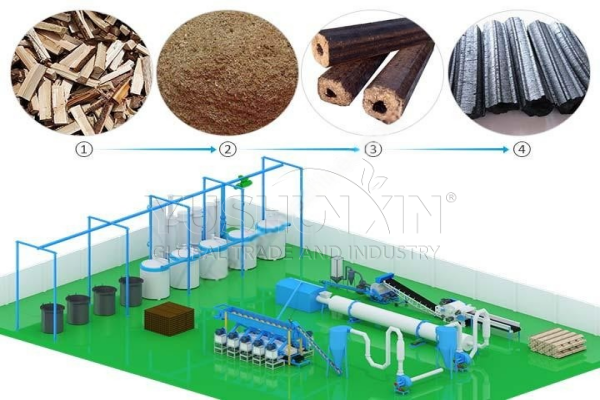The rising demand for sustainable and efficient energy solutions has led to increased interest in wood charcoal briquettes as an alternative fuel source. Briquettes offer numerous advantages over traditional firewood and raw charcoal, such as higher energy efficiency, cleaner combustion, and reduced environmental impact. To produce these briquettes, specialized machines are employed in the production process. This passage explores the various machines that play crucial roles in transforming wood materials into high-quality charcoal briquettes.

Wood Crusher
The first step in the briquette production process involves reducing the size of raw materials. A wood crusher is an essential machine that shreds wood into smaller pieces, making it easier to handle and ensuring uniformity in the briquette production process. Typically, wood crushers can handle various types of raw materials, including branches, logs, and wood chips. By producing smaller and consistent-sized wood particles, the crusher facilitates better compression in the following stages, ultimately resulting in higher quality briquettes.
Dryer
Moisture content is a critical factor in briquette production, as high moisture levels can impede the briquetting process and affect the quality of the final product. A dryer is used to reduce the moisture content of the crushed wood particles to the optimal level required for efficient briquette formation. There are different types of dryers available, such as rotary drum dryers and airflow dryers, each designed to remove moisture effectively. Proper drying ensures that the briquettes burn efficiently and produce less smoke when used as fuel.
Briquette Press
The briquette press is the core machine in the production line, responsible for compressing the dried wood particles into solid briquettes. These machines come in various models, including hydraulic, mechanical, and screw press briquetters, each with unique features tailored to specific production needs. The press applies pressure to the material, binding the particles together without the need for additives or binders, thanks to the natural lignin present in wood. The result is a densely packed, uniform briquette that boasts high energy content and durability.
Carbonization Furnace
To convert the briquettes into charcoal, a carbonization furnace is used. This machine subjects the briquettes to high temperatures in a controlled oxygen-deprived environment, a process known as pyrolysis. During carbonization, volatile compounds are driven off, leaving behind carbon-rich charcoal. The furnace ensures that the transformation is efficient and consistent, enhancing the charcoal’s calorific value and combustion characteristics. Carbonization also reduces smoke emissions, making the charcoal more environmentally friendly.
Packaging Machine
Once the briquettes are carbonized, they are ready for packaging. A packaging machine automates the process, sealing the briquettes in bags for distribution and sale. Proper packaging is essential to protect the briquettes from moisture absorption and physical damage during transportation and storage. Additionally, well-packaged briquettes are more appealing to consumers, enhancing marketability and ease of handling.
Conclusion
The production of wood charcoal briquettes involves a series of specialized machines, each playing a critical role in ensuring the quality and efficiency of the final product. From crushing and drying to pressing and carbonization, these machines streamline the briquette-making process, transforming raw wood into a valuable and sustainable fuel source. With growing interest in renewable energy and environmentally friendly products, the demand for high-quality charcoal briquettes and the machines that produce them is set to rise, contributing to a more sustainable energy future. Visiting: https://www.char-molder.com/product/wood-charcoal-briquette-making-machine/
Leave a Reply